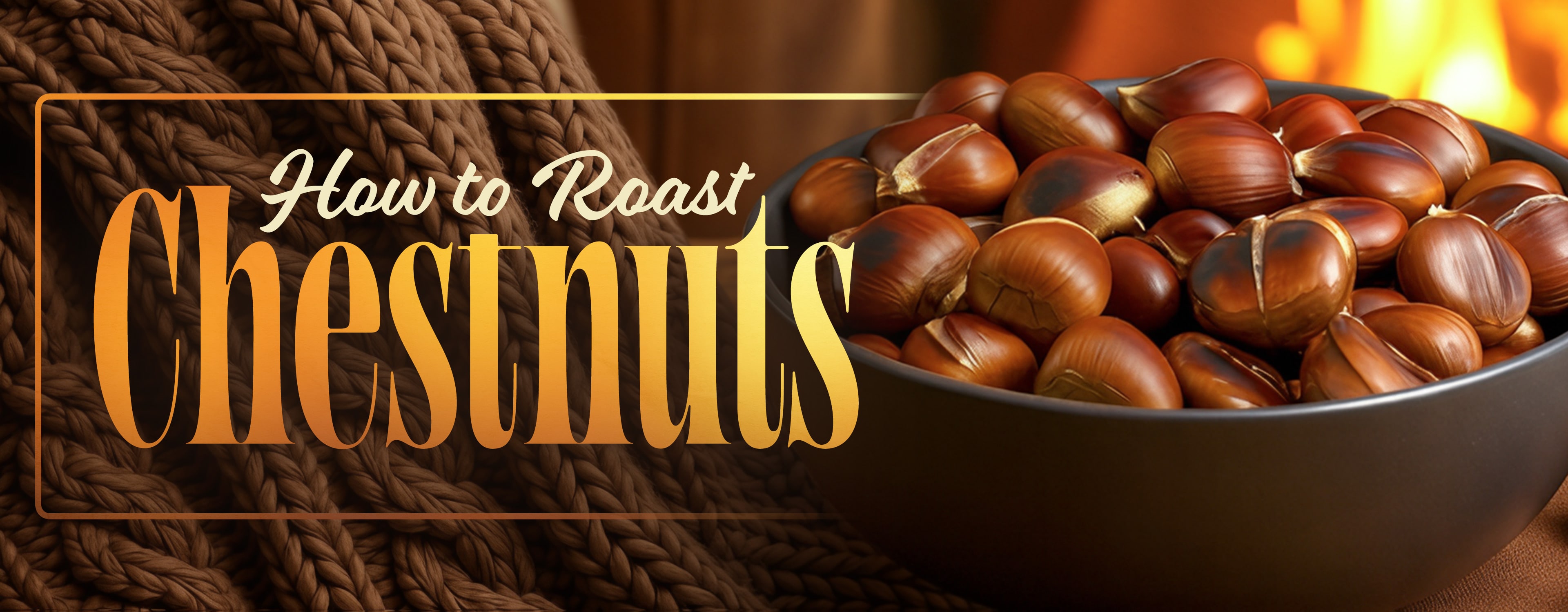How to Roast Chestnuts
Last updated on Oct 20, 2025Corrinn McCauleyWith Jack Frost nipping at your nose, it's the perfect time to roast chestnuts over an open fire. Roasted chestnuts, the muse of Christmas songwriters, are a wonderful winter flavor you can offer customers to get them into the yuletide spirit. Whether you're running a booth at a Christmas market, want a holiday appetizer special, or are incorporating them into a recipe, we guide you through how to roast chestnuts so you can delight patrons with a novel and nostalgic snack.
Shop All ChestnutsHow to Choose Chestnuts
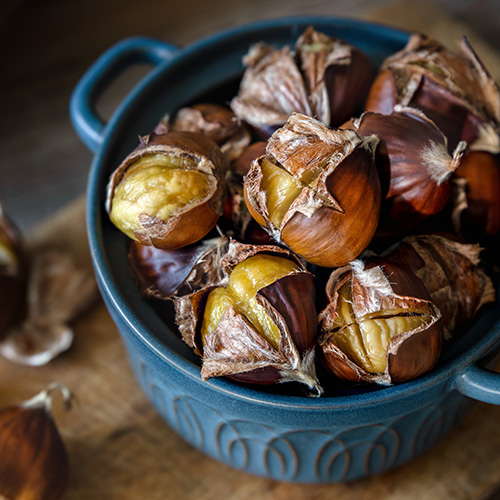
When choosing chestnuts, look for large nuts that feel heavy for their size, are firm to the touch, and have a smooth, glossy shell. Avoid any chestnuts that feel light, as they may be dried out or old. If you shake a chestnut and hear rattling inside, it indicates that the nut is not fresh and may not be of good quality. Choose loose nuts or those in net bags that allow for air circulation to maintain their freshness. Chestnuts stored in sealed bags can become moldy or spoil more quickly.
The two most popular chestnut varieties you'll find are Italian and American chestnuts. When it comes to roasting chestnuts, Italian chestnuts, particularly European sweet chestnuts (Castanea sativa), are the preferred choice over American chestnuts. Italian chestnuts are favored for their larger size and sweeter, more intensely nutty flavor, making them ideal for roasting applications. It's important to note that horse chestnuts, often mistaken for edible chestnuts, are not suitable for roasting or consumption. Horse chestnuts are toxic to humans and should be avoided when selecting chestnuts for roasting.
What Do Chestnuts Taste Like?
Chestnuts are a popular type of nut with a unique flavor profile that is buttery and slightly sweet. When roasted, their texture becomes tender and almost creamy, making them a popular choice for both savory and sweet dishes. The taste of roasted chestnuts is often described as earthy with hints of smokiness and sweetness; some liken it to the taste and texture of a baked sweet potato, making them a versatile ingredient for a variety of recipes. Whether enjoyed on their own or incorporated into dishes, chestnuts add a rich and satisfying flavor that is sure to delight customers.
How Many Roasted Chestnuts per Person?
A general guideline is to estimate about 4 to 6 roasted chestnuts per person as a serving size. This quantity can vary based on the size of the chestnuts, the appetite of your guests, and whether the chestnuts are served as a snack or part of a larger meal. Keep in mind that it's always better to have a little extra than to run out, so consider preparing a few extra servings to accommodate varying preferences and ensure everyone can enjoy this seasonal delicacy.
How to Roast Chestnuts in the Oven
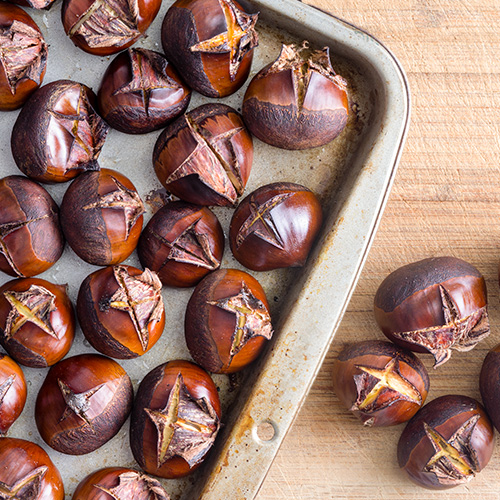
Don't have the capability to roast your chestnuts over an open fire? Roasting chestnuts in the oven is ideal for preparing a batch of roasted chestnuts for guests to enjoy at a holiday event you're catering or for using in other recipes. Follow these steps to achieve perfectly oven-roasted chestnuts:
- Preheat the Oven: Start by preheating your oven to 350 degrees Fahrenheit. This moderate heat will cook the chestnuts evenly, giving them a nice, roasted flavor.
- Score the Chestnuts: Before roasting, make sure to score the chestnuts. This involves making small, X-shaped incisions on the rounded side of each chestnut. This step is crucial as it prevents the chestnuts from exploding during the roasting process.
- Soak the Chestnuts: Place the scored chestnuts in a bowl. Cover them with about an inch of water and let them soak for a minimum of 30 minutes and up to one hour. Once time elapses, remove and pat dry.
- Arrange the Chestnuts: Once the chestnuts are scored, arrange them in a single layer on a baking sheet, ensuring that the flat side is facing down and the slit side is facing up. Make sure there is some space between each chestnut to allow for even cooking.
- Roast in the Oven: Place the baking sheet with the chestnuts in the preheated oven. Allow the chestnuts to roast in the oven for approximately 30-35 minutes, or until you observe the skins pulling back and the nuts inside have softened.
- Steaming the Roasted Chestnuts: Carefully transfer the hot chestnuts from the oven to a damp kitchen towel. Gently lift the ends of the towel to create a bag-like shape, then twist the bag closed. Apply pressure to the chestnuts inside the towel to hear a crackling sound, indicating they are steaming. Allow the chestnuts to sit in the towel for 10-15 minutes. This step is crucial as it helps release any excess steam, making the peeling process easier and more efficient.
- Peeling the Chestnuts: After steaming the chestnuts, it is time to remove the skins. The process is most efficient when the nuts are still warm. To do this, gently pull back on the scoring incisions and peel away the papery skin surrounding the chestnut to unveil the yellow nut inside. Remember to discard any nuts that appear gooey or spoiled.
- Serve and Enjoy: Roasted chestnuts are a versatile treat that can be enjoyed on their own or used in various dishes. Whether you sprinkle them with salt for a savory snack or incorporate them into a stuffing for a vegan Thanksgiving meal, roasted chestnuts are sure to delight your taste buds.
How to Roast Chestnuts on an Open Fire

When it comes to roasting chestnuts on an open fire, having the right equipment is crucial. A specialized chestnut roasting pan or basket is ideal for placing the chestnuts over the flames. These pans typically feature perforated holes that allow heat to circulate evenly around the nuts, resulting in a uniform roast. If you don't have a chestnut roasting pan, a cast-iron skillet, or a wire mesh grill basket can also be used.
Roasting chestnuts on an open fire is a sensory experience, as the crackling flames and aromatic smoke add to the ambiance. Choose hardwoods like oak or hickory for a clean, consistent heat source. Avoid using softwoods or treated wood, as they can impart unwanted flavors to the chestnuts. By following these simple steps and using the right equipment, you can create perfectly roasted chestnuts that are sure to delight your guests and customers.
- Selecting the Best Wood: When roasting chestnuts on an open fire, it's important to choose the right type of wood to feed the flames. Hardwoods such as oak, hickory, or fruit woods like apple or cherry are ideal for creating a hot and consistent flame that will evenly roast the chestnuts.
- Preparing the Chestnuts: Before roasting, it's essential to score the chestnuts with a sharp knife to prevent them from exploding during the cooking process. Make a small incision on the flat side of each chestnut to allow steam to escape while roasting. Soak the chestnuts for 30 minutes to one hour to soften them and make them easier to peel after roasting. Then, pat them dry.
- Selecting Your Pan: Once the chestnuts are prepared, place them in a specialized chestnut roasting pan with perforated holes or a grill basket that can be placed directly over the open fire. The pan or basket allows the chestnuts to roast evenly and prevents them from rolling away.
- Roasting Over an Open Fire: Position the chestnut roasting pan or basket over the hot coals or flames of the fire. Gently push the chestnuts around the pan or rotate the basket occasionally to ensure that they are evenly roasted on all sides. The chestnuts are ready when the outer shell is charred, and the inner nut is tender and cooked through.
- Enjoying the Roasted Chestnuts: Once the chestnuts are roasted to perfection, remove them from the fire and allow them to cool slightly before peeling away the charred outer shell. Enjoy the warm, nutty flavor of freshly roasted chestnuts as a delicious seasonal snack or festive treat. To maintain a steady supply and reduce wait times, store them in a hot holding unit until purchased.
Roasted Chestnuts Recipe
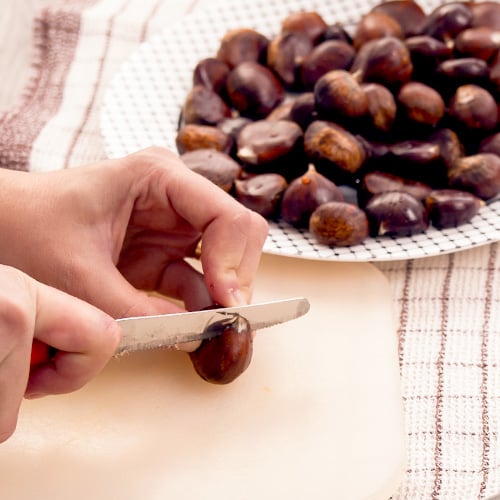
Elevate your roasted chestnut recipe by offering flavor variations and using seasonings to create unique and enticing options for your customers. By experimenting with different flavorings such as cinnamon sugar, truffle salt, and hot honey, you can cater to diverse tastes and preferences, making your roasted chestnuts a standout item on your menu.
- Cinnamon Sugar Roasted Chestnuts: For a classic and comforting flavor, coat roasted chestnuts in a premixed cinnamon sugar seasoning before serving. The warming quality of cinnamon paired with the sweetness of sugar will evoke memories of cozy winter evenings by the fireplace.
- Truffle Roasted Chestnuts: For a luxurious flavor profile, try roasting chestnuts with a drizzle of truffle oil or truffle seasoning. The earthy, umami notes of truffle will elevate the chestnuts to a gourmet level, perfect for upscale dining occasions or special events.
- Hot Honey Roasted Chestnuts: To add a spicy kick to your roasted chestnuts, use premade hot honey or follow our hot honey recipe and then toss the chestnuts in the mixture. The sweet and spicy combination will create a tantalizing flavor that is sure to impress your customers or guests.
- Pickle Flavored Roasted Chestnuts: For a unique and aromatic twist on roasted chestnuts, try seasoning them with a blend of pickling spices. The complex mix of spices, including cloves, black pepper, dill, and mustard seeds, will infuse the chestnuts with a bold and zesty flavor that is sure to stand out.
- Maple Syrup and Smoked Paprika Roasted Chestnuts: To add a sweet and smoky twist to your roasted chestnuts, drizzle them with maple syrup and sprinkle them with smoked paprika before roasting. The combination of the rich maple flavor and the subtle heat from the paprika will create a deliciously unique taste experience.
- Rosemary and Sea Salt Roasted Chestnuts: To bring a savory herbaceous flavor to your roasted chestnuts, toss them with fresh rosemary leaves and a sprinkle of sea salt before roasting. The fragrant aroma of rosemary combined with the subtle saltiness will create a sophisticated and flavorful snack or appetizer.
How to Use Roasted Chestnuts
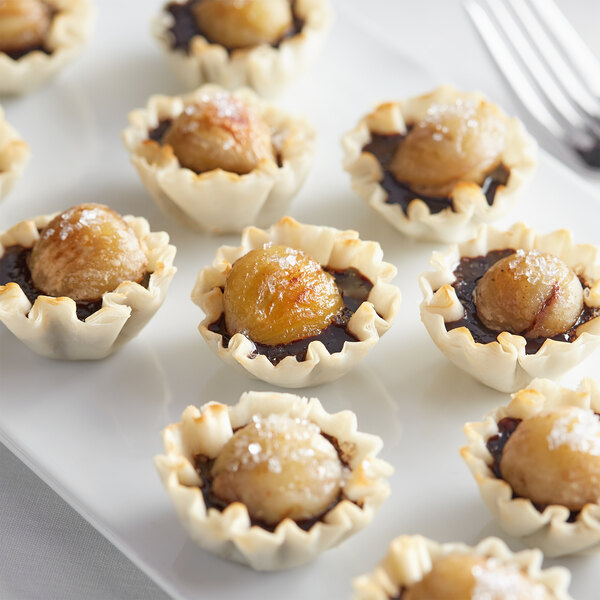
Roasted chestnuts are a delicious and versatile ingredient that can be used in a variety of culinary applications. Once your chestnuts are roasted to perfection, you can enjoy them plain or incorporate them into sweet and savory recipes. Here are some popular ways to use roasted chestnuts:
- Snacking: Roasted chestnuts can be enjoyed as a simple and healthy snack on their own. Their nutty flavor and creamy texture make them a satisfying treat that can be enjoyed any time of day.
- Stuffing: Roasted chestnuts add a rich and earthy flavor to Thanksgiving stuffing recipes. The unique taste and texture of chopped roasted chestnuts complement hearty breads used for stuffing.
- Soups and Stews: Chestnuts can be a delicious addition to soups and stews, providing a toothsome and comforting element to the dish. Simply add chopped roasted chestnuts to your favorite stew or sprinkle them over our pumpkin soup recipe for a touch of warmth and depth of flavor.
- Side Dishes: Roasted chestnuts can be used to enhance a variety of side dishes, such as roasted vegetables, rice pilafs, or grain salads. Their nutty flavor pairs well with a wide range of ingredients, making them a versatile addition to any meal (consider using them as a topping on our pumpkin risotto recipe).
- Desserts: Chestnuts can also be used in sweet dishes, such as desserts and baked goods. From chestnut puree for cakes and pastries to chestnut ice cream or mousse, there are endless possibilities for incorporating roasted chestnuts into your dessert recipes.
How to Store Leftover Roasted Chestnuts
After roasting a batch of delicious chestnuts, it’s important to know how to store any leftovers properly to maintain their freshness and flavor. Here are some simple steps to guide you on how to store leftover roasted chestnuts:
- Peel the Chestnuts: Once the chestnuts have cooled, peel them fully, including removing the tough, paper-like inner skin. Properly peeling the chestnuts is crucial for ensuring their quality during storage.
- Cool the Chestnuts: Allow the roasted chestnuts to cool completely before storing them. This will prevent condensation from forming inside the storage container, which can lead to spoilage.
- Refrigerated Storage: Place the peeled roasted chestnuts in an airtight container if you plan to store them in the refrigerator. They can be kept fresh in the refrigerator for a few days.
- Frozen Storage: Freeze the roasted chestnuts on a tray first to prevent them from clumping together, then transfer them to a freezer-safe bag, removing as much air as possible before sealing it. Frozen roasted chestnuts can be stored in the freezer for up to six months.
Roasting chestnuts is a time-honored tradition that brings warmth and comfort to many during the winter months. Whether you are a restaurant looking to add a seasonal dish to your menu or a catering business aiming to impress clients with a unique offering, mastering the art of roasting chestnuts can elevate your culinary creations. By following the steps outlined in this guide, you can ensure that your roasted chestnuts are perfectly cooked and full of flavor. Embrace the cozy charm of roasted chestnuts and delight your customers with this delicious treat.
